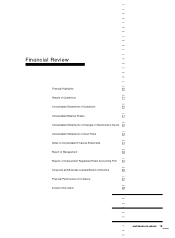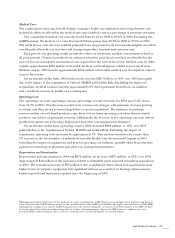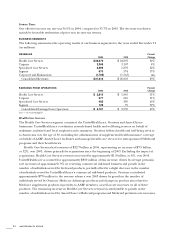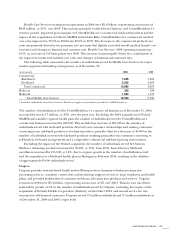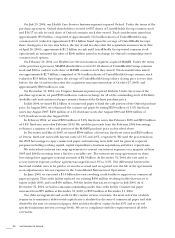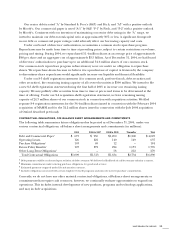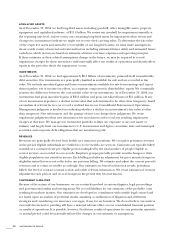United Healthcare 2004 Annual Report Download - page 29
Download and view the complete annual report
Please find page 29 of the 2004 United Healthcare annual report below. You can navigate through the pages in the report by either clicking on the pages listed below, or by using the keyword search tool below to find specific information within the annual report.
UNITEDHEALTH GROUP 27
2003 Results Compared to 2002 Results
CONSOLIDATED FINANCIAL RESULTS
Revenues
Consolidated revenues increased by $3.8 billion, or 15%, in 2003 to $28.8 billion. Consolidated revenues
increased by approximately 11% as a result of rate increases on premium-based and fee-based services
and growth across business segments, and 4% as a result of revenues from businesses acquired since the
beginning of 2002. Following is a discussion of 2003 consolidated revenue trends for each of our three
revenue components.
Premium Revenues Consolidated premium revenues in 2003 totaled $25.4 billion, an increase of $3.5 billion,
or 16%, over 2002. UnitedHealthcare premium revenues increased by $1.8 billion, driven primarily by
average premium rate increases of 12% to 13% on renewing commercial risk-based business. Premium
revenues from Medicaid programs also increased by approximately $1.0 billion over 2002. Approximately
70% of this increase resulted from the acquisition of AmeriChoice on September 30, 2002, with the
remaining 30% driven by growth in the number of individuals served by our AmeriChoice Medicaid
programs since the acquisition date. The remaining premium revenue growth in 2003 was primarily driven
by growth in the number of individuals served by Ovations’ Medicare supplement products provided to
AARP members and its Evercare business, along with growth in several of Specialized Care Services’ businesses.
Service Revenues Service revenues in 2003 totaled $3.1 billion, an increase of $224 million, or 8%, over
2002. The increase in service revenues was driven primarily by aggregate growth of 7% in the number of
individuals served by Uniprise and UnitedHealthcare under fee-based arrangements during 2003.
Investment and Other Income Investment and other income totaled $257 million, representing an increase
of $37 million over 2002, due primarily to increased capital gains on sales of investments. Net capital gains
on sales of investments were $22 million in 2003, compared with net capital losses of $18 million in 2002.
Interest income decreased by $3 million in 2003, driven by lower yields on investments, partially offset by
the impact of increased levels of cash and fixed-income investments.
Medical Costs
The consolidated medical care ratio decreased from 83.0% in 2002 to 81.4% in 2003. Excluding the AARP
business, the medical care ratio decreased 140 basis points from 81.4% in 2002 to 80.0% in 2003. The
medical care ratio decrease resulted primarily from net premium rate increases that exceeded overall
medical benefit cost increases and changes in product, business and customer mix.
Each period, our operating results include the effects of revisions in medical cost estimates related to
all prior periods. Changes in medical cost estimates related to prior fiscal years that are identified in the
current year are included in total medical costs reported for the current fiscal year. Medical costs for 2003
include approximately $150 million of favorable medical cost development related to prior fiscal years.
Medical costs for 2002 include approximately $70 million of favorable medical cost development related
to prior fiscal years.
On an absolute dollar basis, 2003 medical costs increased $2.5 billion, or 14%, over 2002. The increase
was driven primarily by a rise in medical costs of approximately 10% to 11% due to medical cost inflation
and a moderate increase in health care consumption, and incremental medical costs related to businesses
acquired since the beginning of 2002.




